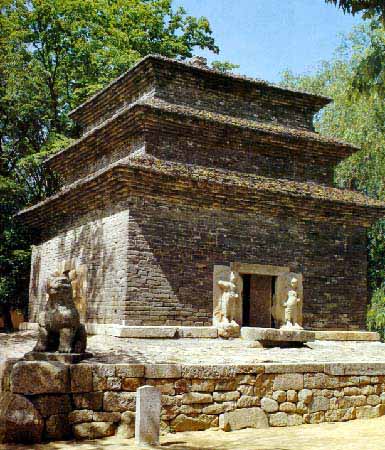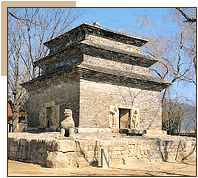Boonhwangsa was constructed in the spring of the 3rd year of Queen
Sunduk's reign.
During the reign of 35th King Kyongduk, in the 14th year, a bronze
image Medicine buddha was cast by Boonhwangsa.
It was later burned, during the Japanese invasion.
In the temple a pedestal of a stale Hwajungkuksa, stone well, a
stone pagoda made to look like brick pagoda, a base of stone lantern
remain. Banner pole supporters are outside the temple. It has a
small pavilion, called Pokwangjon, and Amita Buddha is enshrined.
In 1976, the museum of Dongguk University partly excavated and researched
this temple. Boonhwangsa should be remembered as a place where the greatest Korean
priests-Wonhyo and Chajang-stayed.
It is where the image
of medicine Buddha, made from 366.700 kuns of copper, was enshrined.
The mural by famous Soldier who also painted an old pine at Hwangyongsa,
was also done here. It is said that in the stone well, guardian
dragons lived; thus the name, "defending temple." It is
the first pagoda made to look like brick. Inside, sarira reliquary
was found. In 1965, many stone buddhist images were found in the
pit at the back of Boonhwangsa. Theres are 13 seated Buddhas, a halo, and 6 others.
They are displayed in Kyongju National Museum. Wonhyo established
Haedongjong, a new sect of Buddhist sutra. The temple is called
Boonhwangjong, after him. It shows the deep relation between Wonhyo
and this temple.
When Wonhyo died, his son Seolchong smashed
his remains to make a small image. He enshrined it in the temple
and worshiped it constantly. Every time he prayed, the image turned
around and looked at him! The story reveals how much he loved his
father; but this image was made to turn around for any-one who worshipped
him. Now the image is gone, but one can still feel his warm-hearted
character, and his exciting life. He stayed at this temple, leaving
behind some of his writing.
|

